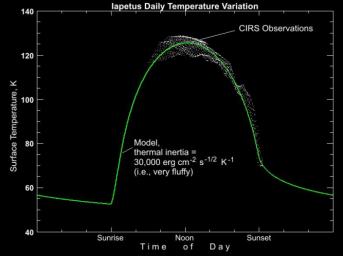
|
Iapetus Temperature Variation Map
- Click the image above for a larger view
- Full-Res JPEG (791 x 591) (42.9 kB)
- Full-Res TIFF (791 x 591) (179.0 kB)
Caption:
This plot shows how daytime temperatures at low latitudes on the dark material on Saturn's moon Iapetus vary with time of day, from about 130 Kelvin (-226 Fahrenheit) at noon to about 70 Kelvin (-334 Fahrenheit) at sunset.
The observations are compared to a "forecast" model (green line) which predicts temperatures based on an assumed value of a parameter called the "thermal inertia." This measures how well the surface can retain heat as conditions change. Rock or solid ice has a high thermal inertia, roughly 2,000,000 as measured in the obscure units used for thermal inertia, meaning that it is good at storing heat and cools down or heats up relatively slowly.
On Iapetus, in contrast, temperatures drop precipitously in the afternoon as the Sun sinks towards the horizon, and a very small value of the thermal inertia (30,000 units) is needed in the model to match the data. This means that Iapetus's surface is extremely bad at storing heat, and is thus extremely fluffy, probably due to the pulverizing effect of billions of years of meteorite impacts, though the mysterious process that has darkened this side of Iapetus may also have played a role.
Background Info:
The Cassini-Huygens mission is a cooperative project of NASA, the European Space Agency and the Italian Space Agency. The Jet Propulsion Laboratory, a division of the California Institute of Technology in Pasadena, manages the mission for NASA's Science Mission Directorate, Washington, D.C. The Cassini orbiter and its two onboard cameras were designed, developed and assembled at JPL. The composite infrared spectrometer team is based at NASA's Goddard Space Flight Center, Greenbelt, Md.
For more information about the Cassini-Huygens mission visit, http://saturn.jpl.nasa.gov and the instrument team's home page, http://cirs.gsfc.nasa.gov/. .
Cataloging Keywords:
| Name | Value | Additional Values |
|---|---|---|
| Target | Iapetus | |
| System | Saturn | |
| Target Type | Satellite | |
| Mission | Cassini-Huygens | |
| Instrument Host | Cassini Orbiter | |
| Host Type | Orbiter | |
| Instrument | Composite Infrared Spectrometer (CIRS) | |
| Detector | ||
| Extra Keywords | Color, Impact, Infrared, Map, Thermal | |
| Acquisition Date | ||
| Release Date | 2005-01-10 | |
| Date in Caption | ||
| Image Credit | NASA/JPL/GSFC | |
| Source | photojournal.jpl.nasa.gov/catalog/PIA07006 | |
| Identifier | PIA07006 | |
